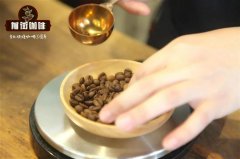Taste and flavor characteristics of sun-dried coffee beans in Guanacaster Canitas Manor, Costa Rica

Professional coffee knowledge exchange more coffee bean information please follow the coffee workshop (Wechat official account cafe_style)
In recent years, Costa Rica coffee beans due to the improvement of American coffee bean production technology, the flavor performance has greatly changed the previous performance with only nutty flavor, and has become an important producing area of fine coffee production. It has also won the favor of many contestants in many international coffee competitions, and Costa Rican coffee beans have been selected as the beans for the competition.
Product name: Costa Rica Guanacaste Finca Las Ca ñ itas Natural
Flavor description: honey apple, tropical fruit aftertaste, black cherry chocolate, acid convergence, calm.
Origin: Guanacaster, Costa Rica
Treatment: tanning type
Recommended cooking equipment: hand flushing / siphon pot / ear-hanging type
Located in northwestern Costa Rica, the Guanacaster Nature Reserve in Costa Rica extends 12 miles from Costa Rica to the Pacific Ocean, crosses the interior along the lowlands along the Pacific coast, crosses three volcanoes, and then subducts to the lowlands. the total length is about 105 kilometers. In 1999, the Guanakast Nature Reserve was listed as a World Natural Heritage site by UNESCO. The reserved area covers a land area of 88000 hectares and a marine area of 43000 hectares, which are not included in the 3000 to 5000 hectares subsequently designated as protected areas. The highest elevation of Guanacaster Nature Reserve is 1916 meters.
The Guanacaster Nature Reserve in Costa Rica includes a series of volcanic areas, the most famous of which is the Rincon-de la Beha volcano, which has three craters and a lagoon. The last observed volcanic eruption was in the 1970s, but there is still a crater that is still erupting, and another 32 rivers and 16 geysers originate near the volcano. The western topography of the reserve is carbonate rock, the rock coastal area is mainly sedimentary topography, and salt lakes are more common in the seaside area. Guanacaster Nature Reserve has a hot climate, and every year from May to October is accompanied by a long rainy season, with annual precipitation as high as 1528 mm and an average annual temperature of 28 degrees Celsius. April to May is the hottest month on the reserve.
The Guanacaster Mountains (Guanacaste,Cordillerade) A section of the continental divide in northwest Costa Rica. From northwest to southeast, it is 113km (70 mi) long, with the highest point 2020 m (6627 ft) above sea level. The Arenal volcano erupted in 1968, covering the entire area and destroying pastures, killing 100000 cattle. The mountains of northwestern Costa Rica. It extends roughly along the border between Guanacaster and Alajuela provinces, running northwest-southeast, with a length of about 113 km. Guanacaster, Costa Rica is mainly composed of andesite. There are four famous active volcanoes, of which Mount Miravayes is 2020 meters above sea level, which is the highest peak of the mountain range. Most of the hillsides are covered with forests, and there is intensive agriculture on the banks of Lake Arenar, growing coffee and sugar cane.
Important Notice :
前街咖啡 FrontStreet Coffee has moved to new addredd:
FrontStreet Coffee Address: 315,Donghua East Road,GuangZhou
Tel:020 38364473
- Prev

Suggestions on the characteristics, flavor and taste of the top coffee brand of St. Roman, Tarazu, Costa Rica
Professional coffee knowledge exchange more coffee bean information please follow the coffee workshop (Wechat official account cafe_style) hand-washed Tarazu San Roman, Costa Rica. 15g powder, medium grinding (small Fuji ghost tooth cutter 4 grinding), v60 filter cup, 88-89 degrees water temperature, the first injection of 30g water, 27 seconds of steaming, injection to 105g water cut off, wait for the powder bed water to half again
- Next

What kind of Brazilian Santos coffee beans do you have? the world famous brand of Brazilian Santos coffee.
Professional coffee knowledge exchange more coffee bean information please follow the coffee workshop (Wechat official account cafe_style) Brazil Santos varieties from South America Brazil is the world's number one coffee producer, accounting for about 30% of the world's total production. Almost all Santos coffee is produced in southeastern Brazil and is the best coffee in Brazil. Raw bean granules range from medium to large, but without green
Related
- Detailed explanation of Jadeite planting Land in Panamanian Jadeite Manor introduction to the grading system of Jadeite competitive bidding, Red bid, Green bid and Rose Summer
- Story of Coffee planting in Brenka region of Costa Rica Stonehenge Manor anaerobic heavy honey treatment of flavor mouth
- What's on the barrel of Blue Mountain Coffee beans?
- Can American coffee also pull flowers? How to use hot American style to pull out a good-looking pattern?
- Can you make a cold extract with coffee beans? What is the right proportion for cold-extracted coffee formula?
- Indonesian PWN Gold Mandrine Coffee Origin Features Flavor How to Chong? Mandolin coffee is American.
- A brief introduction to the flavor characteristics of Brazilian yellow bourbon coffee beans
- What is the effect of different water quality on the flavor of cold-extracted coffee? What kind of water is best for brewing coffee?
- Why do you think of Rose Summer whenever you mention Panamanian coffee?
- Introduction to the characteristics of authentic blue mountain coffee bean producing areas? What is the CIB Coffee Authority in Jamaica?

